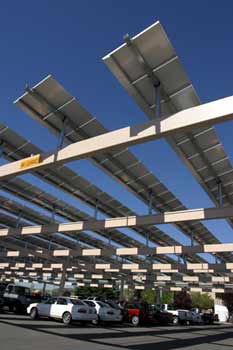By a vote of 6 to 1, the SB1 was approved by the State Assembly Utilities
Committee. It includes provisions solar supporters say are critical to
allow solar to move forward in the state. The CSI, passed earlier this
year, delivered the major items solar proponents struggled for years to
secure; it provided an 11-year rebate structure and the funds to back it
up. But it didn't address some other important items, particularly an
expansion of the state's net-metering cap. These items build upon the CSI
but can only be adopted by the state legislature.
The newly resurrected SB1 would raise the net-metering cap from one-half
of 1 percent to 2.5 percent. The bill will also mandate that some or all
new homes come equipped with solar panels as a standard option. Lastly, it
would require the state's municipally run utilities to adopt their own
solar rebate programs.
All three components could encounter some friction from the host of
special interests with a stake in electricity generation and transmission,
solar energy and labor. Bernadette Del Chiaro, clean energy advocate for
Environment California and sponsor of SB1, expects a similar labor
interest component to play a part in this bill's progress -- or its
challenges. Since the long-term rebate structure and its funding were
approved by the PUC with the CSI, Del Chiaro doesn't expect the same level
of acrimony that dogged the bill in legislative sessions past. But she
does expect some resistance to the mandate of solar on new homes with the
fact that SB1 doesn't contain provisions for solar installations to be
done under so-called prevailing wages.
Jan McFarland, executive director of Americans for Solar Power (ASPV),
which represents a cross-section of industry interests, says the expansion
of the net-metering cap is the most important item that can be addressed
in SB1. She added that the mandate requiring solar on new homes would most
likely be for projects of 50 homes or more.
David Hochschild, executive director of PV Now, another group representing
the solar industry, agrees with McFarland that raising the net-metering
cap is the most important item included in SB1. He also feels strongly
about the importance of requiring municipalities, such as the Los Angeles
Department of Water and Power, to shoulder the same support for solar
energy as the investor-owned utilities do. This, he added, offered a rare
moment of agreement between some unlikely parties.
"The municipalities will be resisting that, at least some of them will,"
Hochschild said. "Interestingly, this is one of the areas where there is
agreement between the solar industry and the utilities as they're both
competing against the municipalities."
Having recently passed the State Assembly Utilities Committee, SB1 will
eventually head to the Assembly Floor for a final vote. Before then,
however, the final language of the bill is likely to be altered in one way
or another.
Del Chiaro was pleased with the recent vote but said she hoped the
legislature would act quickly, "...and without any weakening amendments,
so that California can continue on its way to becoming a world solar power
leader."
In the meantime, a series of workshops are under way at the CPUC and the
California Energy Commission to finalize the CSI. All indications so far
are that the entire program in California will be shifted from an upfront,
dollar-per-installed watt rebate, to a performance-based incentive, as is
currently the norm with the majority of European solar rebate plans.

